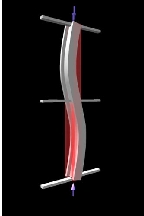For long columns (large slenderness ratio s), the Euler Buckling Strength reduces rapidly. For very short columns (small s) the Buckling Strength is large. However, the column's strength cannot exceed the material's compressive strength Sc. Depending on the slenderness ratio, a column fails by either:
- Material Failure (e.g., yielding in metals), or
- Geometric Instability (buckling)
A transition point between yielding and buckling can be determined by setting the buckling strength equal to the yield strength: scr = Sy. The Transition Slenderness Ratio is then:


Critical Stress vs.
Slenderness Ratio




